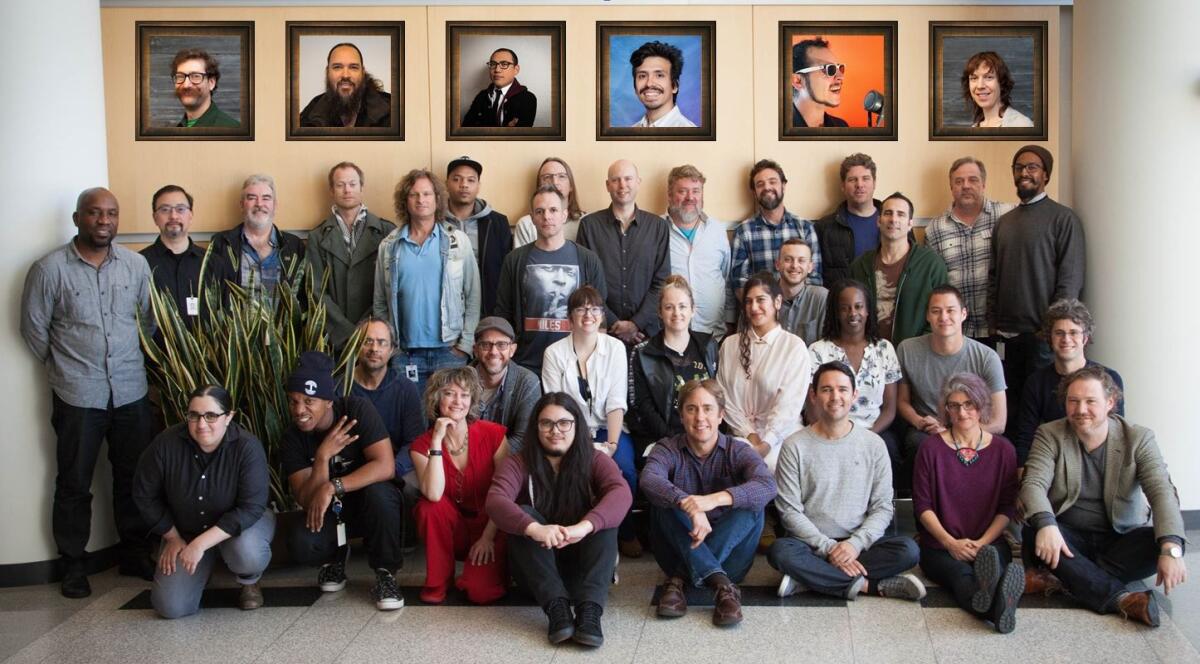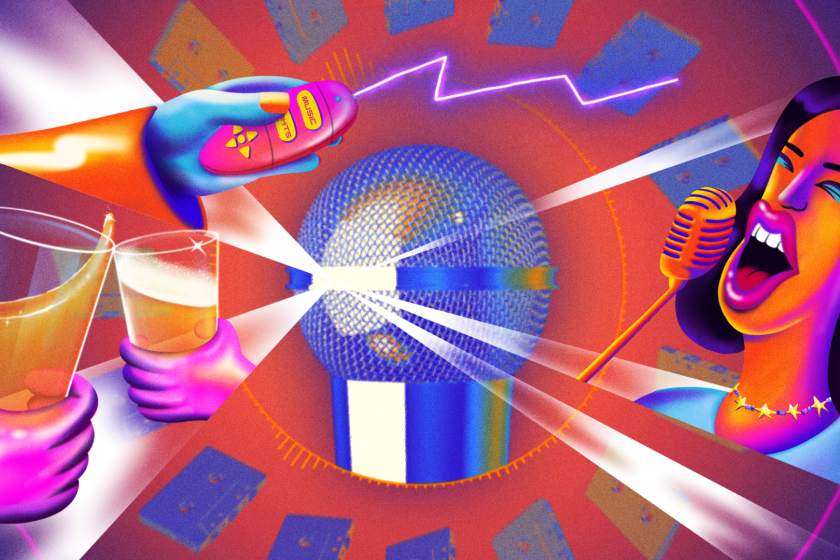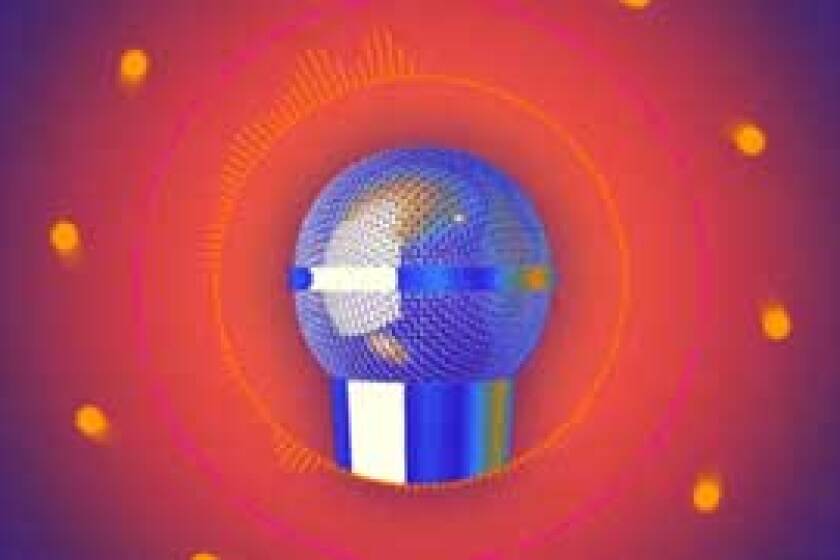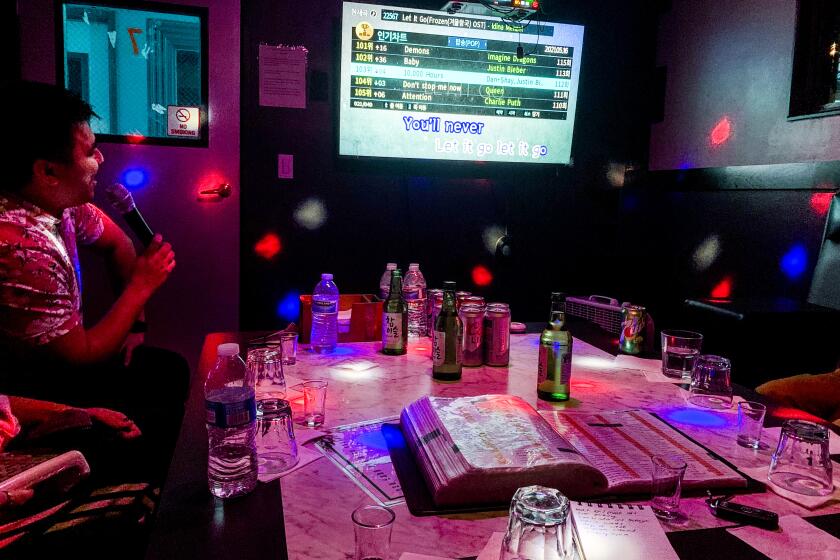We built a karaoke song generator. Here’s how you and Pandora helped

- Share via
Choosing the perfect karaoke song is a mix of art and science. So when we set out to create the ultimate guide to finding your go-to karaoke songs, we needed some musicians and data analysts.
There’s a slight distinction between a good song and a good karaoke song. A good karaoke song is not only about what you want to sing; it’s also about reading the audience. So first, we needed you to tell us what your favorite karaoke songs were — and why.
You shared whether you preferred singing songs from when you were young or popular songs now. You shared whether you preferred sticking with something danceable or choosing something you could dramatically belt — which songs you sang when you wanted to impress, and which songs were guaranteed to get the crowd to sing along.
Once we collected more than 600 suggestions, we turned to Pandora’s Music Genome Project.
Steve Hogan leads the music analysis team at Pandora and SiriusXM — he’s also the organist for the San Francisco Giants — and Hannah Glass is a musician, vocalist and avid karaoke singer who is Pandora’s rap and hip-hop analyst. We asked them to explain how their team helped us break down karaoke song recommendations that we collected from readers into categories including vocal range, mood, difficulty — and whether the song has an exceptional singalong chorus.
This Q&A has been lightly edited for clarity.
How does Pandora’s Music Genome Project work?
Hogan: Our team is made up entirely of musicians, and our job is to provide the company with a detailed understanding of our music library. The Music Genome Project is a highly detailed musical taxonomy that allows us to describe songs and artists along many dimensions — including musicological characteristics (harmony, rhythm, melody); details of instrumentation and vocal performance; genre and stylistic influences; lyrics; studio production; and more.
Over the past 20 years, we have applied this detailed analysis to millions of songs and hundreds of thousands of artists, and this data allows our science and engineering teams to develop recommendation strategies for our music-streaming products.
We are able to accurately understand the musical closeness — or distance — of any two analyzed tracks, and this allows our science and engineering teams to create an unmatched “sounds like” recommendation engine for our listeners. Our motto is “humans for quality, machines for scale.”
How did you categorize the vocal range for these karaoke songs?
Hogan: Our goal for this project was to try to fit each song’s vocal range on a three-point scale: low, medium, high.
Some artists are easily characterized this way — Johnny Cash generally sings low, while Mariah Carey generally sings high — but many songs that become radio hits span multiple vocal ranges, sometimes as much as three octaves.
So in general, we tried to get a sense of the full note range within a song, with special consideration for the hooks — the most catchy and memorable parts.
Once the melody crosses a certain threshold — for a male voice, the G note above middle C on a piano, or for a female voice, the high C, an octave above middle C — that’s getting pretty darn high for a non-trained singer, so we are likely to characterize that song as “high,” especially if those high notes are part of the hook. Admittedly, it is sometimes a tough call.
Dive bars, live bands, noraebangs, ’80s nights or Hello Kitty decor — there’s a karaoke bar or private room in Los Angeles for everyone.
We decided to categorize each karaoke song into five moods: “Just dance,” “Swagger,” “Bare your soul,” “Get happy” and “Rage on.” Can you tell us about what went into consideration when categorizing each mood?
Hogan: For the “Just dance” option, we are looking for an energetic dance vibe. No cheek-to-cheek slow dances here! In general, these songs fall somewhere in the 90- to 130-beats per minute range, and they keep the energy level fairly consistent throughout.
Ideally the rhythm section of drums and bass keep the rhythms fairly simple and easy to latch onto, with a consistent backbeat on beats 2 and 4. Bonus points for the classic “4-on-the-floor,” disco-style kick drum.
For “Swagger,” we are looking for songs that exude an attitude of confidence or self-assuredness. Maybe even a little cockiness. This is largely dependent on the lyrics and the intensity of the vocal delivery, but that attitude usually carries over to the musical accompaniment as well. You can find swagger in many genres, but hip hop and hard rock tend to over-index.
For the “Bare your soul” mood, we are looking for highly emotional songs featuring sentiments like love, heartbreak, lamentation, nostalgia and remorse — you get the picture. These are the songs that tug at your heartstrings. In addition, the music and vocal delivery is generally slower and more sentimental, to match the lyrical subject matter.
For the “Get happy” mood, we are looking for songs that give off an undeniable feel-good vibe. This is tied to both lyrical sentiment — positive, uplifting, or funny in a good natured way — and to the mood of the music. Happy points are awarded for a bouncy rhythm, major key harmony and catchy, singable melodies.
If you feel like you need to blow off some steam, the “Rage On” mood might be for you. These songs reside in the more aggressive corners of the musical universe, with lyrics containing angry sentiments and subject matter. Musical elements might include hard-hitting drums, distorted instrument effects and a higher-intensity vocal delivery style.
What data went into determining the difficulty of a song in karaoke?
Hogan: There are several factors we considered when evaluating the difficulty level. First, some melodies are inherently difficult to sing if they have large melodic leaps; an extremely wide range from low to high; or they incorporate non-diatonic notes — that is, notes that don’t naturally occur in the home key of the song.
Some songs are difficult because of the rhythmic phrasing. It could be very fast or rhythmically tricky in how the lyrics land against the beat.
Lastly, we rated some songs as difficult because the iconic version features a powerhouse vocal delivery with impressive vocal riffs and ornaments that only the most daring karaoke enthusiast would try to conquer.
How do you determine whether a song has a good singalong chorus?
Hogan: We tried to keep a high bar for what we called a singalong chorus. Certainly, most songs on the list are catchy, all-time hit songs, but to make the “Singalong chorus” list, the chorus should be repeated a lot, and it should be the dominant focus, or hook, of the song.
And ideally, the chorus is repeated at least a couple of consecutive times at the end of the song.
Furthermore, the song should be so firmly entrenched in pop culture that a room full of karaoke revelers would find it hard to resist joining in.
Lastly, when filtering through the quiz, there are some combinations that will have more results than others. Are there any hacks you suggest for those who want to discover more song options that might work for them?
Glass: Alto and baritone songs are in a comfortable range of most people’s speaking voices, whereas classical soprano and tenor pieces are in a falsetto range quite high to sing without formal training. So the excitement of singing, or often belting, those mezzo-soprano songs comes from the strain of challenging the high end of one’s vocal range. That’s why, generally, big hit songs tend to be in that vocal register. It draws a strong emotional response.
If you like a song but it’s not in a comfortable vocal range for you, my first advice would be: Who cares? Be brave, feel the adrenaline and go for the Grammy! Confidence is key!
But for my fellow altos, the melodic range of female alto songs and male tenor songs very closely overlaps; for example, Rihanna and Queen.
Oftentimes bass voices can easily sing soprano range songs, just an octave lower.
Another hack to discover more song options is finding one that feels good and checking out that artist’s catalog for the same style. And what kind of music analyst would I be if I didn’t suggest making a Pandora station with that song and seeing what comes up?
Did you discover anything new about karaoke while working on this project?
Glass: I discovered a lot of unique song options for my voice, spanning multiple genres and decades.
Also, if I ever had a distaste for karaoke as a musician, I certainly don’t now. You don’t need to write or produce music to be a superstar. Karaoke made singers like Frank Sinatra and Britney Spears iconic household names.
One venue owner says that business is “60%, 70%” of what it once was. If you are planning to belt some Whitney among friends, experts recommend masking up.
About The Times Utility Journalism Team
This article is from The Times’ Utility Journalism Team. Our mission is to be essential to the lives of Southern Californians by publishing information that solves problems, answers questions and helps with decision making. We serve audiences in and around Los Angeles — including current Times subscribers and diverse communities that haven’t historically had their needs met by our coverage.
How can we be useful to you and your community? Email utility (at) latimes.com or one of our journalists: Jon Healey, Ada Tseng, Jessica Roy and Karen Garcia.
More to Read
Sign up for The Wild
We’ll help you find the best places to hike, bike and run, as well as the perfect silent spots for meditation and yoga.
You may occasionally receive promotional content from the Los Angeles Times.















